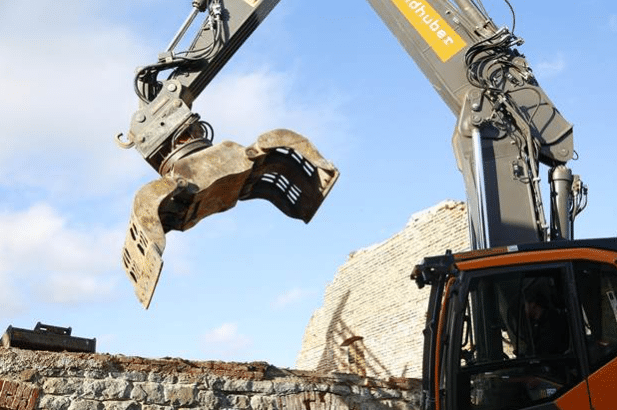Importance of Advanced Demolition in Urban Development
As cities expand and populations grow, the need for efficient land use becomes critical. Older buildings that no longer meet safety standards or urban planning requirements must be demolished to accommodate new developments. Traditional demolition methods, such as wrecking balls and explosives, often result in excessive noise, dust, and debris, causing significant disturbances in densely populated areas.
Advanced demolition techniques address these challenges by incorporating precision engineering, environmental considerations, and innovative machinery. These methods ensure that demolition projects are completed safely, quickly, and with minimal environmental impact.
Key Advanced Demolition Techniques
1. Implosion
Implosion is one of the most dramatic yet controlled demolition techniques. It involves strategically placing explosives in a building’s structural supports to ensure the structure collapses inward, minimizing damage to surrounding properties.
This method is ideal for tall buildings in urban areas where space is limited. Engineers use computer simulations to determine the exact placement and timing of explosives, ensuring a controlled collapse. While implosion is highly efficient, it requires extensive planning and expertise to prevent accidents.
2. High-Reach Excavators
High-reach excavators are specialized demolition machines equipped with extended arms and heavy-duty attachments, such as hydraulic shears and crushers. These machines are used to dismantle buildings piece by piece from the top down, reducing dust and noise pollution.
This technique is particularly useful in tight urban spaces where traditional wrecking balls would be impractical. High-reach excavators allow for selective demolition, where specific parts of a building can be removed while preserving adjacent structures.
3. Selective Demolition (Deconstruction)
Unlike traditional demolition, which involves complete destruction, selective demolition focuses on carefully dismantling a building to salvage reusable materials. This method is environmentally friendly, as it reduces waste and promotes recycling.
Materials such as steel, concrete, wood, and bricks can be recovered and repurposed for new construction projects. Selective demolition is labor-intensive but offers long-term sustainability benefits, making it a preferred choice for eco-conscious urban development.
4. Robotic Demolition
Robotic demolition involves using remote-controlled machines to demolish structures in hazardous or hard-to-reach areas. These robots are equipped with hydraulic breakers, crushers, and cutting tools, allowing for precise demolition without risking human safety.
This technique is commonly used in unstable structures, asbestos removal, and confined spaces. Robotic demolition minimizes worker exposure to dangerous conditions while improving efficiency.
5. Hydro demolition
Hydro demolition uses high-pressure water jets to break down concrete structures. This method is highly precise, allowing for the removal of damaged concrete while leaving the reinforcement bars intact.
It is commonly used in bridge repairs, parking structures, and industrial facilities where structural integrity must be maintained. Hydro demolition reduces dust and vibration, making it suitable for urban environments.
6. Dust and Noise Suppression Techniques
Urban demolition projects must comply with strict environmental regulations. Advanced dust suppression systems, such as misting cannons and water sprays, are used to control airborne particles. Similarly, noise barriers and acoustic enclosures help minimize disruptions to nearby residents and businesses.
These measures ensure that demolition activities do not negatively impact air quality or public health.
Benefits of Advanced Demolition Techniques
1. Enhanced Safety
Advanced demolition methods prioritize worker and public safety. Techniques like robotic demolition and controlled implosion reduce the risk of accidents, while selective demolition minimizes hazardous exposure.
2. Environmental Sustainability
Modern demolition practices emphasize recycling and waste reduction. By salvaging materials and using eco-friendly methods like hydro demolition, urban development projects can significantly lower their carbon footprint.
3. Cost Efficiency
While some advanced techniques require higher initial investments, they often lead to long-term cost savings. Reduced waste disposal fees, recycling materials, and faster project completion contribute to overall economic efficiency.
4. Minimal Urban Disruption
Cities cannot afford prolonged demolition-related disruptions. Advanced techniques like high-reach excavators and noise suppression ensure that projects are completed with minimal impact on traffic, businesses, and residents.
Challenges in Advanced Demolition
Despite their advantages, advanced demolition techniques come with challenges:
- High Initial Costs: Specialized equipment and skilled labor can be expensive.
- Regulatory Compliance: Urban demolition must adhere to strict environmental and safety regulations.
- Logistical Constraints: Tight urban spaces may limit the use of certain machinery.
However, with proper planning and expertise, these challenges can be effectively managed.
The Future of Demolition in Urban Development
The demolition industry continues to evolve with advancements in technology. Future trends may include:
- AI-Powered Demolition Robots: Autonomous machines that can analyze structures and execute precise demolitions.
- Green Demolition Practices: Increased use of biodegradable materials and zero-waste demolition strategies.
- 3D Scanning for Precision: Laser scanning and 3D modeling to enhance demolition accuracy.
As urban areas become more congested, the demand for smarter, safer, and more sustainable demolition techniques will only grow.
Conclusion
Advanced demolition techniques are revolutionizing urban development by making the process safer, faster, and more environmentally friendly. From controlled implosions to robotic demolition, these methods ensure that cities can grow sustainably while minimizing disruptions.
As technology continues to advance, the demolition industry will play an even greater role in shaping the future of urban landscapes. By adopting these innovative techniques, developers can contribute to smarter, greener, and more efficient city planning.
